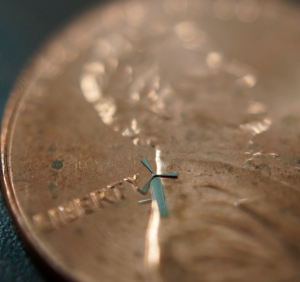Honey, I Shrunk The Windmills! To The Size Of An Ant
From KERA News Breakthroughs:
Commercial wind turbines stand more than a hundred feet tall, with blades nearly as long. The wind turbines developed by engineers at the University of Texas at Arlington are a bit smaller… just half than the size of an ant.
In a cold lab room at UT Arlington electrical engineering professor J.C. Chiao shows off a windmill. It’s mounted on a grain of white rice. The micro windmill is a tiny speck of metal with a rectangular base and three shiny blades the size of ant antenna.
“Just think about it this way,” Chiao says, “My interest and research focus is to shrink things.”
The windmills aren’t for a science fiction project. They’re meant to harvest wind energy and deliver small bursts of energy to compact devices like remote sensors or cell phones.
Wind Power For Your Cell Phone
Smitha Rao, a university research associate at UT Arlington, came up with the design for the tiny turbines.
“We visualized that we could have a panel of these outside to power your outdoor lighting,” she says.
The idea developed as Rao and Chiao talked, and Rao says her enthusiasm gave Chiao another idea:
“I was waving my hands and Dr. Chiao was like guess what else you could use it for? To charge your cell phone!”
That’s right, a sleeve connected to your phone’s battery would have the windmills mounted on top.
“So theoretically if you wave your hand enough you should be able to generate enough power to send that one important text message,” Rao says.
Different Design Challenges
Creating windmills with parts a fraction of the diameter of a human hair was a real challenge.
Rao says at first the blades just weren’t spinning with her original flat design.
That’s when she notice something about her daughter’s pinwheel one evening.
“I realized it had this curved structure that made it rotate much faster,” Rao says. “Even when she was barely waving it and I said that’s what I need to do – I need to create that artificial curvature on the blades to make it move faster.”
The problem was in trying to create that curvature at such a small level from two-dimensional metal pieces.
So Rao worked with a Taiwanese electro-mechanical fabrication company on a new layering process. The result are blades that aren’t exactly curved, but have a step-like structure that appears smooth and helps with rotation.
A lot of people think small is weak. But Chiao says going small can mean less waste, lower cost and more efficiency. That’s why engineers across the country are developing Microelectromechanical systems, or MEMs devices for applications in energy, medicine and transportation.
Still, there are concerns unique to miniature mechanics. Two in particular:
- Moisture: “For the big windmill, moisture is not an issue, you can rain and the windmill still works. But for our device, moisture is a major issue. When it is very humid, the water molecule may go into the one micron gap and become glue. So it won’t move at all.”
- Dust: “One small dust gets in there it will jam the device.”
Chaio and Rao are still optimizing the mechanics of the windmills. Then, they hope to see them in action, perhaps harvesting energy to recharge your cell phone.


